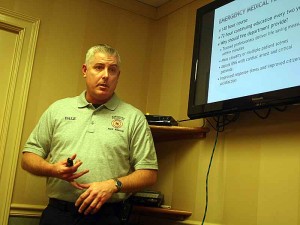Chief makes case for firefighter pay hike, study of possible merger
By JIM BROOKS
Nelson County Gazette / WBRT Radio

Bardstown Fire Chief Marlin Howard discusses the possible benefits of merging the two fire departments operating from Station 1 on North Fifth Street.
Tuesday, March 12, 2015, 11:45 p.m. — Merging the city-funded Bardstown Fire Department and the dues-funded Bardstown-Nelson County Volunteer Fire Department Inc. is a goal worth studying, Chief Marlin Howard reported to the Bardstown City Council’s safety committee Thursday evening.
The two fire departments are funded separately, but share equipment and manpower. The two departments have operated as one since the volunteer department — known as “the corporation” — was created in 1966. Howard serves as chief of both departments.
Merging the departments won’t affect fire protection or raise taxes, Howard explained. The biggest changes will be streamlining the administrative side of operating two departments independently of one another. A merger will eliminate duplication of services, streamline the chain of command and simplify department funding issues, he said.
As an example, Howard noted that volunteer firefighters receive a $15 stipend for responding to a fire. But deciding which department pays that stipend depends on where the fire was located. If the fire was in the city limits, the city department pays the stipend; if the fire was outside the city limits, the corporation pays.
The separation of the two departments is necessary because they are funded separately. The separate funding requires extensive record keeping to determine which one department purchased what pieces of equipment — from flashlights to safety equipment — so supplies (and flashlight batteries) can be charged to the correct department.
“We work well together technically, but we need to tie it all together administratively,” he said.
Mayor John Royalty told the committee he began talking with both fire departments shortly after the November election, and said he believed exploring a merger is worthwhile.
Howard said he will seek bids from consulting firms for a study on merging the departments and how to do so effectively. The cost of the study could run as high as $20,000.
Howard stressed that raising fire dues or creating a fire district isn’t on the table in any discussion of merging the fire departments.

Firefighter Dale Charles explains the pilot program that will train fulltime city firefighters as EMTs.
FIREFIGHTER / EMT PILOT PROGRAM. A one-year pilot program is set to begin soon that will provide EMT training for the City of Bardstown’s fulltime firefighters.
Firefighter Dale Charles, who is also a registered nurse and EMT, told the committee that an EMT class will begin April 3 for five of the eight fulltime Bardstown firefighters who are not already EMT certified.
The 140-hour course is being conducted in conjunction with Nelson County EMS.
The pilot program’s goal is to have two firefighter/EMTs who can respond with EMS weekdays on calls involving critical injuries or illnesses requiring immediate attention.
Nationally, more than 70 percent of fire departments provide EMT care, Charles told the committee. Locally, more than half of all fire department calls also involve EMS care.
FIREFIGHTER PAY. Howard told the committee that the existing pay scale for full-time firefighters is no longer competitive with other fire departments of similar size.
Starting pay is lower, and advancements aren’t adequate to be an incentive for firefighters to stay. As an example, Howard said an eight-year firefighter is earning only $1,000 more than starting pay for a new firefighter.
One way to improve firefighter pay is to offer step raises based on training certifications. “The step raises wouldn’t be a gimme,” Howard explained. Firefighters who improve skills by earning certifications could earn step raises for each certification; firefighters who let those certifications expire would lose the step raise.
Raising firefighter pay to where it should be based on experience and training would add $92,000 to the fire department’s budget. Capt. Todd Spalding suggested that a five-year program could gradually increase wages and set starting pay at a competitive level.
MORE FULL-TIME FIREFIGHTERS NEEDED. To improve fire protection, the fire department needs to add additional full-time firefighter positions, Howard explained.
The average response time — the time between receiving a call until the first truck leaves the station — is 2-1/2 minutes between the hours of 8 a.m. and 4 p.m. on weekdays when the station has full-time staff available.
After 4 p.m., that response time jumps to 8 minutes, and between midnight and 8 a.m. increases to 12-1/2 minutes. The longer response times point to the need for more full-time firefighters to maintain quality fire protection, he said.
“None of this takes away from our volunteers, who are an exceptional group,” Howard said.
Even if additional full-time firefighters are hired, local volunteers will remain a vital part of fire protection, he said.
HYDRANT REPLACEMENT. Howard told the committee the fire department has identified eight fire hydrants in the city that are out of service. Three of those will be converted to flush hydrants because they are supplied with 3 or 4-inch water lines which cannot flow enough water for fire protection.
The repairs will be made by the city’s public works department, which Howard credited with having helped with repairs on numerous hydrant problems in the past. With many hydrants in the city 50 years old or older, Howard suggested that a program to replace several hydrants each year could replace older ones prone to malfunctions.
-30-






